January 2025
The global water and wastewater treatment market size is calculated at USD 369.60 billion in 2025 and is forecasted to reach around USD 652.30 billion by 2034, accelerating at a CAGR of 6.50% from 2025 to 2034. The Asia Pacific water and wastewater treatment market size accounted for USD 136.20 billion in 2025 and is expanding at a CAGR of 8.50% during the forecast period. The market sizing and forecasts are revenue-based (USD Million/Billion), with 2024 as the base year.
The global water and wastewater treatment market size was estimated at USD 347.90 billion in 2024 and is predicted to increase from USD 369.60 billion in 2025 to approximately USD 652.30 billion by 2034, expanding at a CAGR of 6.50% from 2025 to 2034. Wastewater and water treatment is the procedure of enhancing the quality of wastewater and transforming it into an effluent that can be either recycled or returned to nature with little impact on the environment.
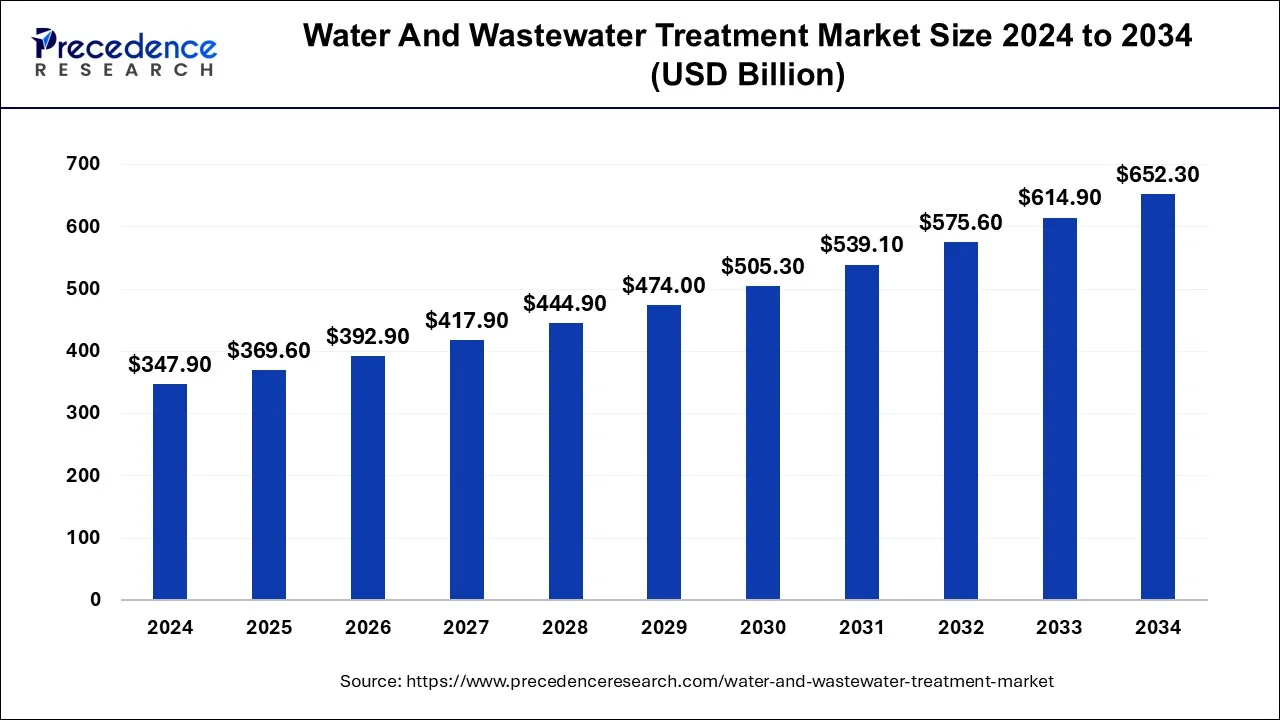
The Asia Pacific water and wastewater treatment market size was estimated at USD 125.60 billion in 2024 and is predicted to be worth around USD 282.8 billion by 2034, at a CAGR of 8.5% from 2025 to 2034.
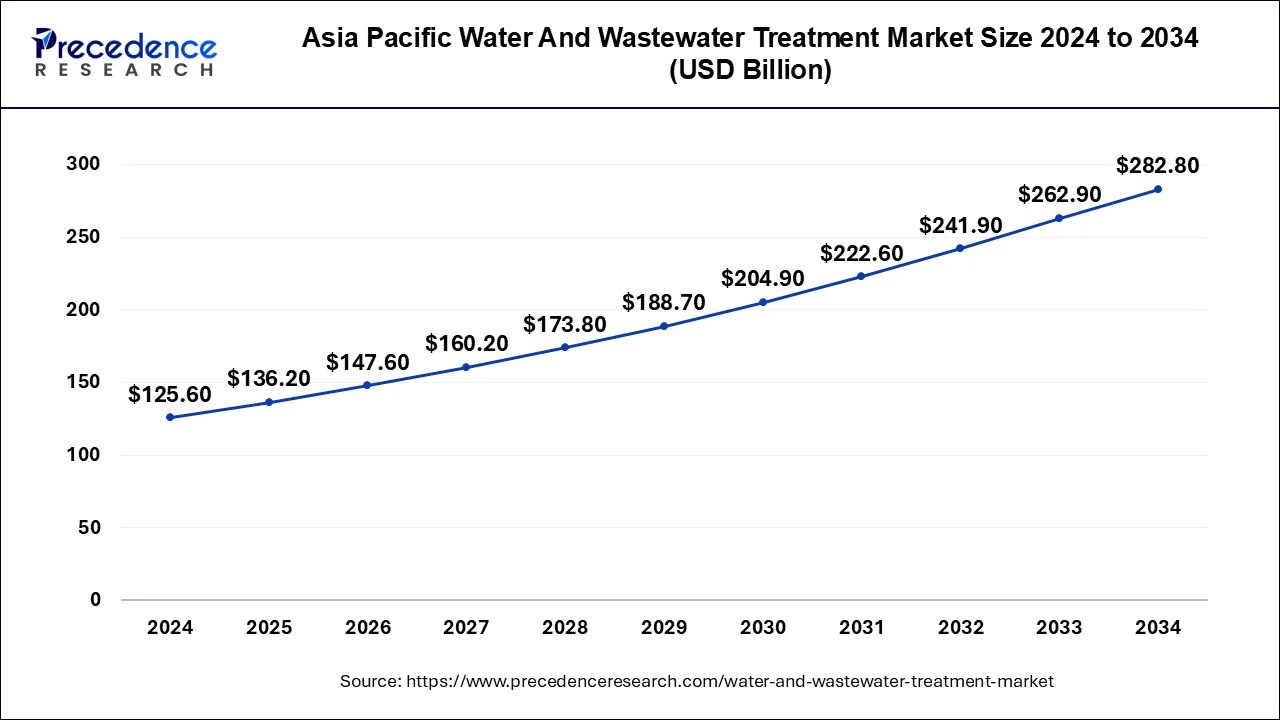
Asia Pacific dominated the water and wastewater market in 2024. The rising concerns over water scarcity and environmental pollution are observed to act as major supporting factors for the market to expand in Asian countries. Growing urbanization, insufficient infrastructure, and rising health risks are other factors to promote the market’s growth in the upcoming years. Countries such as China and India have already started advanced wastewater treatments that clearly promote the integration of advanced technologies in such services. Additionally, countries with high populations in Asian areas are required to add additional water treatment capacity to upgrade the currently employed ones. On the other hand, the booming industrial segments in the Asian area create another potential for the market to grow.
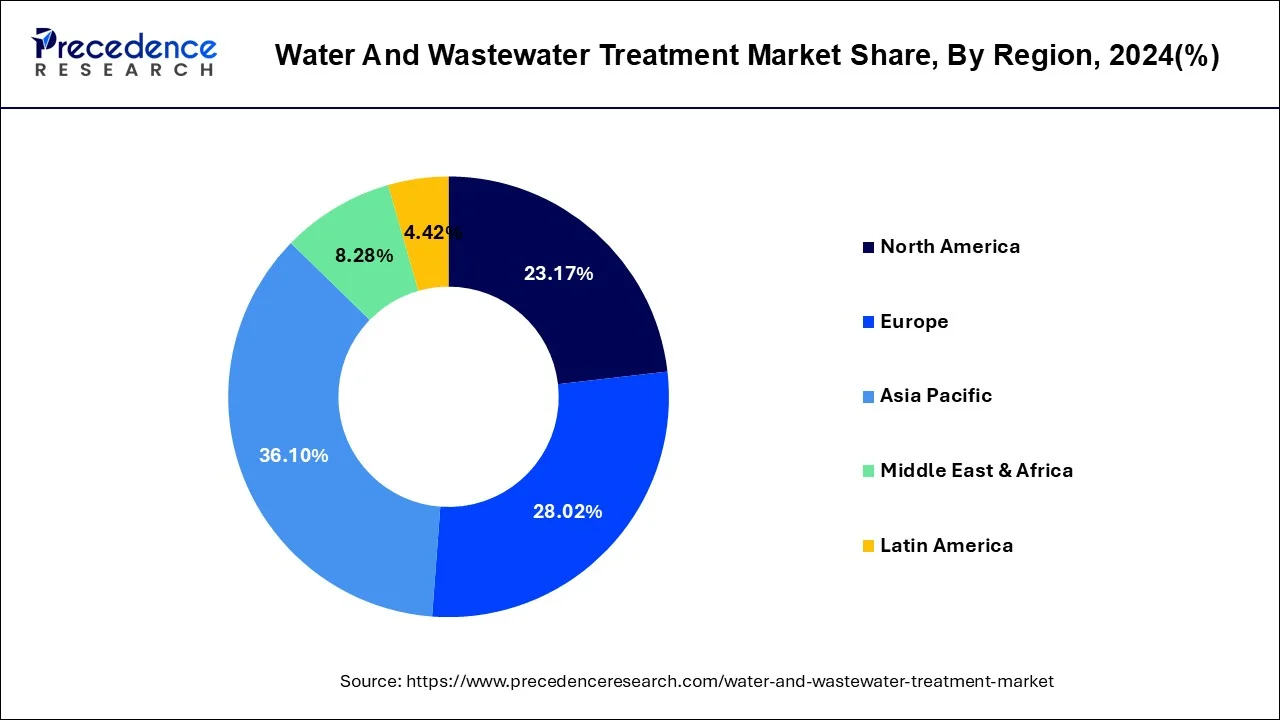
One major element driving the market expansion of wastewater treatment chemicals is the growing worry about the depletion of freshwater resources. In order to prevent and resolve such issues and improve the reusability of wastewater in the process, governments of many nations throughout the world are putting tight laws and regulations into place. A number of governments are also actively interested in enhancing municipal water infrastructure in both urban and rural locations. The demand for water & wastewater treatment chemicals is anticipated to increase during the forecast period as a result of such advancements in industrial and domestic/municipal water treatment. Rapid industrialization is also contributing to rising groundwater pollution, particularly in developing nations. Because of this, governments in many nations are launching programs to use wastewater effectively, which is predicted to increase demand for chemicals used in wastewater treatment. Globally, the COVID-19 pandemic has had a detrimental effect on a number of businesses and nations. Lockdown has been implemented all over the world, which has halted the manufacture of electronic components and limited the market's growth for chemicals used in water and wastewater treatment. The delivery of raw materials needed to manufacture electrical components has also been delayed. Regulations governing the import and export of chemicals and raw materials have an impact on the supply chain as a result of the COVID-19 pandemic. The paucity of raw materials, therefore, has an influence on the manufacture of chemicals for water treatment, which also has an effect on the market expansion.
Additionally, it was expected that until the second quarter of 2022, production halts brought on by staff illnesses and mandated firm closures would restrain the market's expansion for water treatment chemicals. Additionally, it was anticipated that as a result of the decline in production, manufacturing, oil & gas, and other activities, the market for water treatment chemicals would grow more slowly by 2020. With a market share of 33.05% in terms of revenue, Asia Pacific excluding Japan led all other regions in 2022 for water and wastewater treatment chemicals, followed by North America and Europe, respectively.
| Report Coverage | Details |
| Market Size in 2024 | USD 347.9 Billion |
| Market Size by 2034 | USD 652.3 Billion |
| Growth Rate from 2025 to 2034 | CAGR of 6.5% |
| Largest Market | Asia Pacific |
| Base Year | 2024 |
| Forecast Period | 2025 to 2034 |
| Segments Covered | By Equipment, By Process, and By Application |
| Regions Covered | North America, Europe, Asia-Pacific, Latin America, and Middle East & Africa |
Growing pulp and paper industry
Increasing population and globalization
In 2024, the membrane separation market category dominated with 34.77% of worldwide revenue. Membrane separation is a physical treatment method that removes certain components from the solution by forcing high-pressure feed water through a semi-permeable membrane. Membrane separation is superior to alternative techniques in a variety of ways, including a small operational space and excellent filtration effectiveness. After the first treatment, the residual pollutants are typically removed using a secondary technique known as biological treatment. Strict laws are designed to use environmentally friendly methods to reduce water pollution in the industry and municipal sectors. The need for biological treatment equipment is anticipated to rise in developed markets including the U.S., Canada, Germany, and Japan.
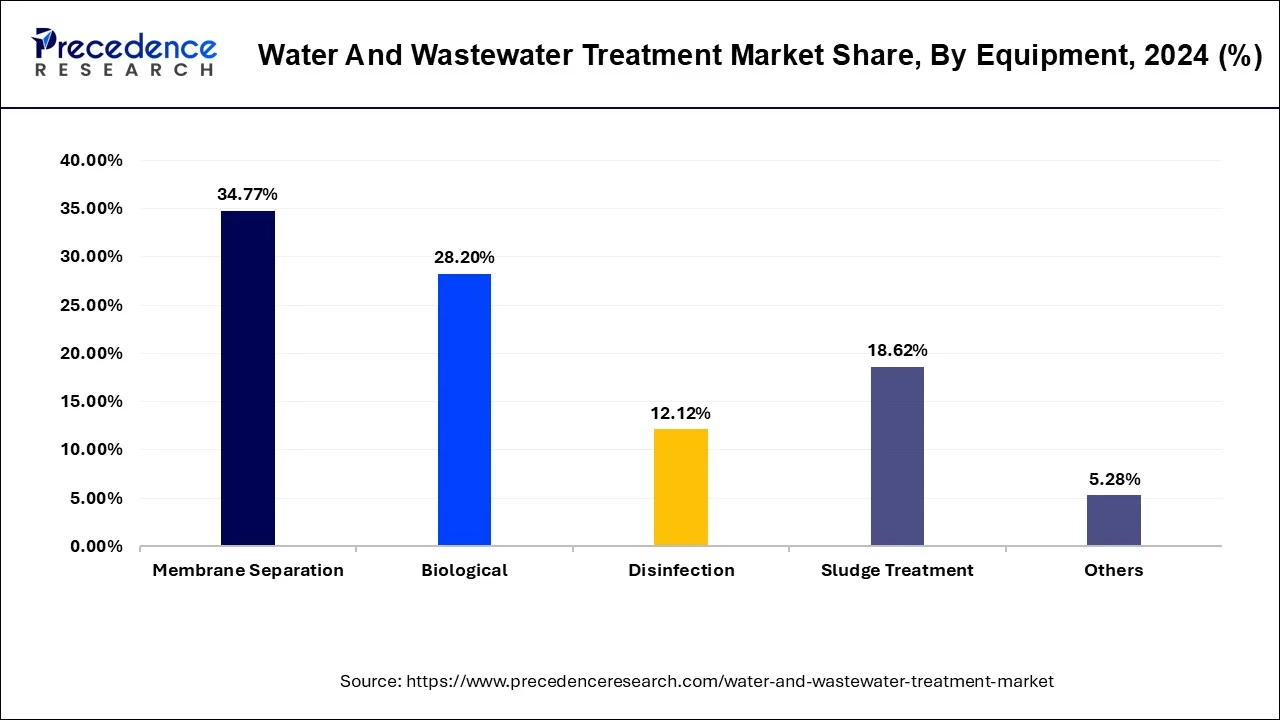
The biological segment is observed to be the fastest growing at a CAGR of 6.9% during the forecast period. Biological treatment methods are versatile and can target a wide range of contaminants found in water and wastewater, including organic compounds, nutrients (e.g., nitrogen and phosphorus), and certain toxic substances. This versatility allows biological treatment systems to address diverse water quality challenges encountered in different industrial, municipal, and environmental settings.
Many environmental regulations and discharge standards require the removal of organic pollutants and nutrients from wastewater before discharge into receiving water bodies. Biological treatment systems are well-suited to meet these regulatory requirements, as they can achieve high levels of pollutant removal and ensure compliance with water quality standards.
Global Biotechnology Market Revenue, By Equipment, 2022-2024 (USD Billion)
| By Equipment | 2022 | 2023 | 2024 |
| Membrane Separation | 107.2 | 113.9 | 121.0 |
| Biological | 89.5 | 95.4 | 101.6 |
| Disinfection | 37.5 | 39.8 | 42.2 |
| Sludge Treatment | 57.9 | 61.2 | 64.8 |
| Others | 16.8 | 17.6 | 18.4 |
The market was dominated by the tertiary treatment process category in 2024, accounting for about 43.73% of global revenue, and is anticipated to grow at the quickest CAGR of 6.3% from 2025 to 2034. Prior to reuse or environmental release, effluent quality is improved by tertiary treatment. In order to make water suitable for reuse, this method eliminates the inorganic chemicals, viruses, germs, and parasites that remain after subsequent treatment procedures. For the purpose of removing heavy sediments and floating objects from effluent, the first treatment is utilized. Water and pollutants are separated from wastewater by passing it through a number of tanks and filters. During the projected period, it is anticipated that low operating costs and strong market visibility will be extremely important in expanding the main treatment's application area.
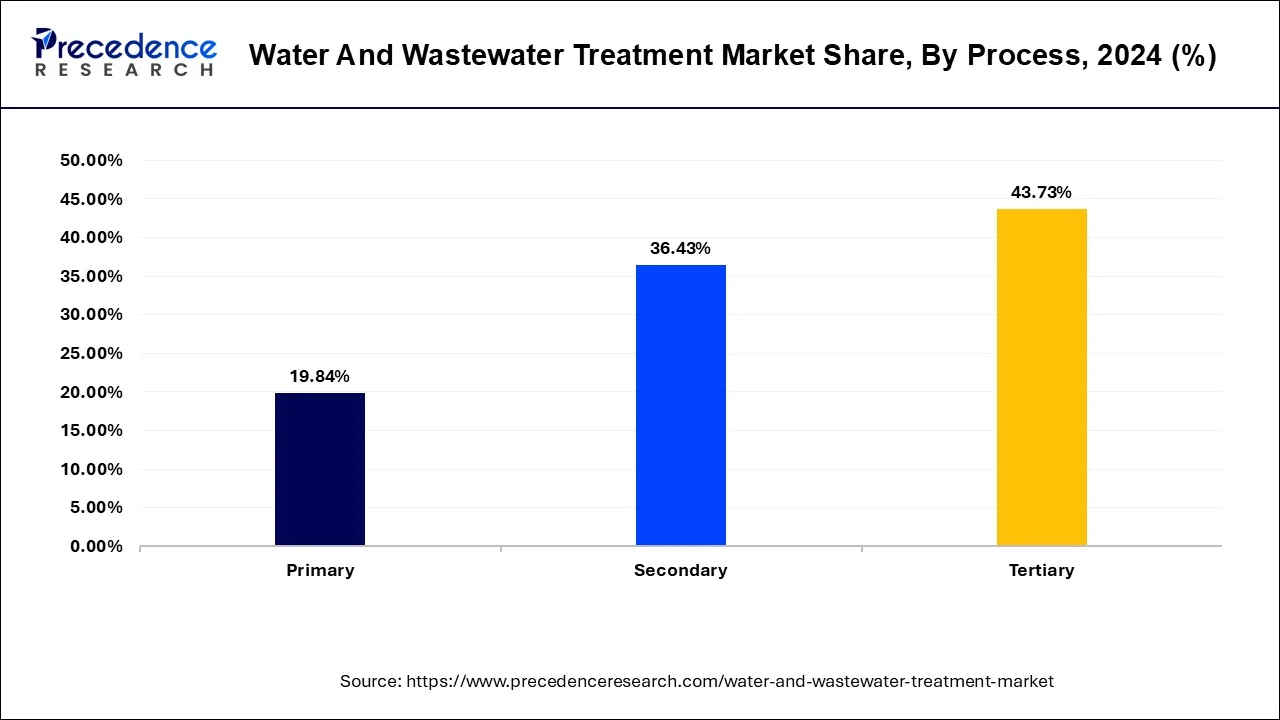
From 2025 to 2034, the secondary treatment process category is anticipated to grow at the second-fastest CAGR of 6.8%. Utilizing trickling filters, bio-towers, rotating biological contactors, and activated sludge systems, secondary treatment is primarily used to remove soluble organic waste and compounds, such as phosphorus and nitrogen. Aerobic or anaerobic biological processes can be employed in subsequent therapy. A membrane bioreactor is a cutting-edge treatment system that combines membrane filtration with traditional biological treatment methods like the activated sludge process to remove suspended and organic particles more effectively and efficiently. Using microfiltration or ultrafiltration membranes, solid-liquid filtration is accomplished.
Global Biotechnology Market Revenue, By Process, 2022-2024 (USD Billion)
| By Process | 2022 | 2023 | 2024 |
| Primary | 61.6 | 65.2 | 69.0 |
| Secondary | 111.9 | 119.1 | 126.8 |
| Tertiary | 135.6 | 143.6 | 152.1 |
The industrial segment held the dominating share of 66.03% in 2024. Industrial activities generate a variety of pollutants and contaminants that must be treated before being discharged into the environment to comply with environmental regulations. Regulatory bodies impose strict standards for wastewater discharge, requiring industries to invest in effective water and wastewater treatment technologies to meet compliance requirements. Advances in water and wastewater treatment technologies have made it increasingly feasible for industries to treat their wastewater on-site or recycle water for reuse in their processes. Innovative solutions, such as membrane filtration, biological treatment systems, and advanced oxidation processes, offer efficient and cost-effective methods for treating complex industrial wastewater streams.
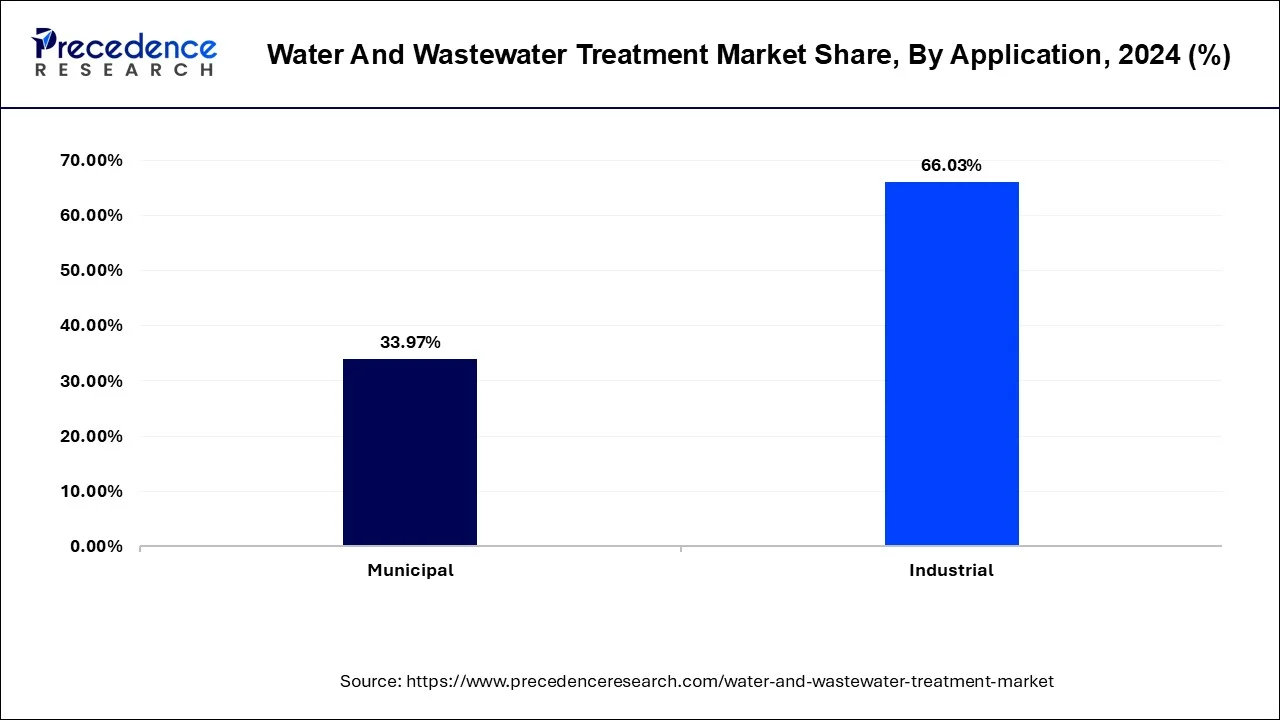
By Equipment
By Process
By Application
By Geography
For inquiries regarding discounts, bulk purchases, or customization requests, please contact us at sales@precedenceresearch.com
No cookie-cutter, only authentic analysis – take the 1st step to become a Precedence Research client
January 2025
September 2024
October 2024
October 2024